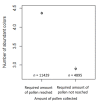CSI Pollen: Diversity of Honey Bee Collected Pollen Studied by Citizen Scientists
- PMID: 34821788
- PMCID: PMC8625907
- DOI: 10.3390/insects12110987
CSI Pollen: Diversity of Honey Bee Collected Pollen Studied by Citizen Scientists
Abstract
A diverse supply of pollen is an important factor for honey bee health, but information about the pollen diversity available to colonies at the landscape scale is largely missing. In this COLOSS study, beekeeper citizen scientists sampled and analyzed the diversity of pollen collected by honey bee colonies. As a simple measure of diversity, beekeepers determined the number of colors found in pollen samples that were collected in a coordinated and standardized way. Altogether, 750 beekeepers from 28 different regions from 24 countries participated in the two-year study and collected and analyzed almost 18,000 pollen samples. Pollen samples contained approximately six different colors in total throughout the sampling period, of which four colors were abundant. We ran generalized linear mixed models to test for possible effects of diverse factors such as collection, i.e., whether a minimum amount of pollen was collected or not, and habitat type on the number of colors found in pollen samples. To identify habitat effects on pollen diversity, beekeepers' descriptions of the surrounding landscape and CORINE land cover classes were investigated in two different models, which both showed that both the total number and the rare number of colors in pollen samples were positively affected by 'urban' habitats or 'artificial surfaces', respectively. This citizen science study underlines the importance of the habitat for pollen diversity for bees and suggests higher diversity in urban areas.
Keywords: Apis mellifera; COLOSS; citizen science; diversity; foraging ecology; landscape; nutrition; season.
Conflict of interest statement
Authors declare no conflict of interest.
Figures













References
-
- McLellan A.R. Factors Affecting Pollen Harvesting by the Honeybee. J. Appl. Ecol. 1976;13:801. doi: 10.2307/2402256. - DOI
-
- Coffey M.F., Breen J. Seasonal Variation in Pollen and Nectar Sources of Honey Bees in Ireland. J. Apicult. Res. 1997;36:63–76. doi: 10.1080/00218839.1997.11100932. - DOI
-
- Dimou M., Thrasyvoulou A. Seasonal Variation in Vegetation and Pollen Collected by Honeybees in Thessaloniki, Greece. Grana. 2007;46:292–299. doi: 10.1080/00173130701760718. - DOI
LinkOut - more resources
Full Text Sources
Research Materials
Miscellaneous

